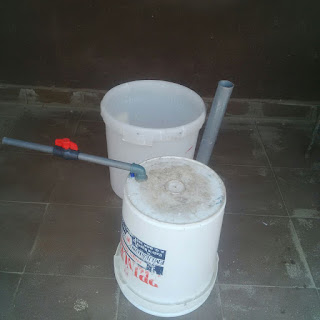Biogas is the gas produced from digestion of organic materials under anaerobic condition, and the gas can be used for heating, lighting and to generate electricity.
Suitable materials for substrate:
* Plant leftovers from the garden, park, parks and surroundings
* Peels, wastes of fruits and vegetables and food leftovers at home
* Liquid and solid manure of animals: pig, cattle, poultry and other animals
* sewage and waste water sludge from waste water treatment. This substrate may contain phosphorus, nitrate, heavy metal and may not be considered as high quality substrate.
* Energy crops such as grains.
* Industrial food wastes from processing of fruits, vegetables and meat.
Maximum potential of gas production per tonne of substrate
* Cow manure - 25m3/ton
* Pig manure - 35m3/ton
* Whey - 55m3/ton
* Spent grains - 75m3/ton
* Loppings. - 110m3/ton
* Domestic organic wastes - 120m3/t
* Industrial food waste - 220m3/t
* floating slurry - 400m3/t
* waste food, grease and oil - 600m3/t
Source: wikipedia
The following inputs are toxic and should be avoided in the plant:
* Antibiotics
* Denitrification agents
* Zinc, copper, ammonia, fatty acids and hydrogen sulphide
Temperature of the plant should be regulated and made constant by stiring the substrate regularly.
During the digestion, the substrates are transformed into methane, carbon dioxide and small quantity hydrogen sulphide, nitrogen, hydrogen and oxygen.
Percentage by composition of biogas
Methane CH4. 50 - 75%
Carbon dioxide 25 - 50%
Nitrogen. 0 - 10%
Hydrogen. 0 - 1 %
Hydrogen sulphide 0 - 3%
Oxygen. 0 - 5%
Conditions reqd for anaerobic digestion
* Temperature between 15 - 55%
* PH value between 6.5 - 8.0
* Avoid antibiotics
Environmental benefits of biogas production
* It reduces emission of methane
* Reduces dependence on energy
* Provides quality organic fertilizer and
* Reduces unpleasant odour.
Anaerobic digestion process
The process passes through 4 phases before completion
Phase 1
Hydrolysis by anaerobic bacteria that convert
Carbohydrates into sugar,
Fats into fatty acids, and
Protein into Amino acids
Phase 2
Acidification by acid forming bacteria that convert
Sugar into carbonic acid,
Fatty acids into alcohol,
Amino acids into hydrogen, ammonia and carbon dioxide
Phase 3
Acetoficsation by acid bacteria that convert
Carbonic acids into acetic acids,
Alcohol to hydrogen and carbon dioxide
Phase 4
Methanogenesis by methane forming bacteria that convert
Acetic acids to methane and carbon dioxide
Components of biogas plant
Digester: it contains the substrate and passes the digestate out. The digestate is used as fertilizer.
Stirrer or mixer: used to stir the substrate and make it homogeneous
Gas holder: it collects the gas from the digester.
Benefits of biogas
* Renewable source of energy
* Provides income for farmers
* Reduces green house emissions
* Reduces odour, destroys pest and weed seeds
* Provides quality organic fertilizer
Feeding the biogas (small-scale production)
The plant can be fed initially with cow dung mixed with water at 1:1 by volume, fill to half of the digester and allow to stay for a week. Thereafter, subsequent addition of other organic materials can be done daily until the plant is full. Large-sized organic waste materials should be chopped into pieces before they are fed into the plant. Different organic materials (animal dungs, poultry wastes, weeds food leftovers etc) can be mixed together and fed into the plant. Place the biogas plant where it will get maximum sunlight throughout the day.
Testing the gas
The gas produced initially will contain a lot of impurities and may not burn. You need to empty the gas once or twice before it starts to burn readily or when the quality has increased. Biogas can not be used directly without removing the impurities such as water vapour, carbon dioxide, hydrogen sulphide and dirty particles. Biogas can be mixed with and supplied as natural gas after all impurities have been removed.
Types of biogas plant
There are different designs and types of biogas plants. Available materials, environmental and ecological conditions are put into consideration for construction of biogas plant.
* Floating Drum Plant: This consists of a digester and gas holder placed on it. The gas holder floats on the the digestate and moves up and down according to the quantity of gas stored
* Fixed Dome Biogas Plant: This consists of a closed, dome shaped digester with immovable gas holder and a displacement pit, also known as compensation tank in which digested slurry is collected.
*** submit comments, enquiries and contact us for training on how to build biogas plant for household use and to make money ***








No comments:
Post a Comment